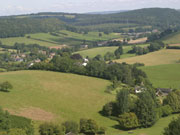 |
 |
 |
 |
Did you know that there used to be a 34 mile long canal between Hereford and Gloucester, and that it is being restored? The Herefordshire and Gloucestershire (H&G) Canal, with 21 locks, was one of the last to be constructed in England. Promoted on a fairly doubtful commercial footing during the canal mania of the 1790s, its "business plan" included serving the coalfields near Newent. The enabling Act of Parliament was passed in 1791, and the first stretch between the River Severn at Over near Gloucester to Ledbury, via Dymock and Newent, was completed in March 1798, but construction of the remainder from Ledbury to Hereford was delayed such that its opening took place almost half a century later in May 1845. The whole project cost close to £245,000, several times the original estimate!
However, by 1845 railways were rapidly expanding and taking over the haulage of goods around the country from canals. Thus the commercial viability of the H&G Canal, always somewhat precarious, was gradually lost, and in June 1881 its operations ended and the Great Western Railway, which had bought the canal company some few years earlier, started construction of a line from Ledbury to Gloucester using much of the same route. Of course that railway line is now closed too.
The canal meandered through some of the prettiest countryside in the two counties. The poet laureate, John Masefield, was much taken with it in its early days when he lived as a child in Ledbury, and he recorded vivid recollections, particularly of the boat people. Perhaps his life-long romance with boats and water began then (he ran away to sea as a boy).
The line of the canal can still be seen in places on ordnance survey maps, and on the ground, and some of the original structures survive, perhaps the most complete being a lock, lock keeper's cottage and the remains of an aqueduct at Oxenhall, near Newent. Some other features and short lengths of canal have been restored, largely by volunteer members of the H&G Canal Trust, including most notably the Wharf House (now a very good restaurant) and canal basin at Over. The planned Edgar Street Grid development in Hereford has as its centrepiece a brand new canal terminal basin.
Full restoration will likely take many years, not least because the necessary large funding for major project work will not be available in the short to medium term. But an enthusiastic Canal Trust team of volunteers is pressing on with the work at several locations along the route. Membership of the Trust is increasing and funds are being raised in order to purchase land and to progress work. The necessary land is now protected from any development, and all local authorities (councils) are fully committed in their respective Local Plans to the restoration and to safeguarding the route. The restored canal will provide leisure facilities other than just boating, such as walking routes and cycle tracks on the towpaths. It will also play a significant role in flood protection at some locations. Finally (for now) the Trust intends that the restored canal will be economically self-sufficient and not dependant on local taxpayers for any subsidies. It is aware that income from boating and fishing alone will not be enough, so it employs imaginative new methods to assure that the funds it will need will be forthcoming.